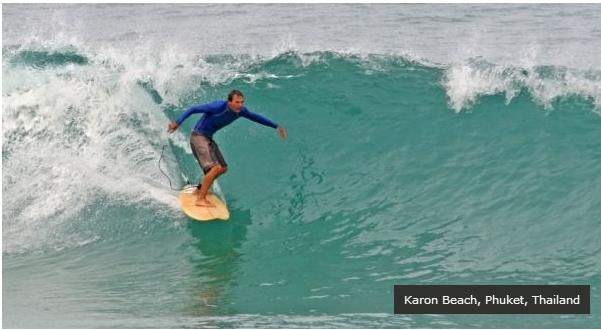Published on February 2, 2010

Over the past decade, surfing in Thailand has surged in popularity.What was once a pastime for expats and tourists has now become just as popular with locals. Like much of Southeast Asia, the biggest waves in Thailand roll in between April and September. These swells coincide with South Western monsoons and waves usually follow several days of overly windy, un-surfable conditions. Once they arrive waves can be small (0.5m) to medium (1.5m) and are always warm (28 degrees centigrade).
While still fun for the experienced surfer, waves in Thailand are great for beginners and, unlike Indonesia or the Philippines, they’re never too strong or pushy. Add to this the cheap accommodations and friendly locals and you’ve got a fantastic destination for a first surf trip.
Kalim Reef (a right-hander) and Karon Beach in Phuket, are two of the most popular surf beaches in Thailand and have access to tons of hotels, guest house and restaurants nearby. One Thai surfer remarked, “You can have an absolutely brilliant time. I’ve spent literally hundreds of hours on my local reef surfing alone or with just a few mates, enjoying the warm water and stunning scenery – true soul surfing even in the tourist jungle that is Phuket.”
For those in search of more challenging waves, or something off the beaten path, Koh Kradan Island, down near Trang is home to some deep-water waves that will surprise the most seasoned surfer. There are also new surf spots constantly being discovered, and surfers are encouraged to explore the Thai mainland – both the east and west – in search of other secret gems to add to the Thai surf-map.
Whereas the west-side of Thailand (i.e. Phuket) get swells from southern monsoons (the same monsoons bringing waves to Indonesia and Sri Lanka), places like Rayong and Koh Samui and surrounding areas on the east side of Thailand get their share of waves as well.However waves here are less consistent and are generated from the northern monsoons in China and Japan.
For some, Thailand may be the first place they ever surf and renting a board is made easy at one of the destination shops. Short boards, body-boards and Mals (long-boards) are all available and generally at very reasonable prices.There is friendly advice and tuition available from shops like Phuket’s Saltwater Dreaming or Phuketsurf. Board rentals and surf lessons are also available at the southernmost end of Kata Beach and generally costing 800-1000 baht per lesson. This includes board rental for 1.5 hours and you’ll be taught to paddle, duck-dive, sit and stand on the board…if you’re a quick learner. After your lesson check out The Tube for a surf-inspired BBQ or Ska Bar to share some after dinner tales of the epic barrels you scored or bailed on during the day.
If you are thinking of taking a board (or boards) to Thailand, remember to check with airlines for excess baggage charges. One of the best airlines for surfers tends to be Virgin Atlantic, carrying boards in addition to your free baggage allowance at no extra charge. Easyjet and Flybe are also good choices for surfers.These budget airlines charge no more than their standard excess luggage rates. At the other end of the scale is Air France charging €150 for any item exceeding of the standard baggage allowance, and British Airways who do not allow any surfboards on their flight. Remember though, many manufacturers are producing boards in Thailand, and you might be surprised at the price of Thai made boards by European, US and Australian surfboard brands. So be prepared to take home a bargain.
Other well-known surf beaches in Thailand include:
- Kata Yai Beach
- Nai Harn Beach
- Kata Noi Beach
- Kamala Beach
- Surin Beach
- Nai Yang Reef
- Pakarang Point Khao Lak
In 1993 Ean Johnston left London for greener pastures and found himself hooked on board sports, spending a decade pursuing waves and good snow. A freelance journalist, he now resides in wave rich New South Wales with his wife and two daughters.






